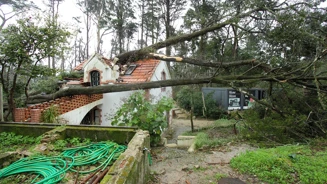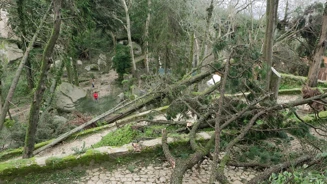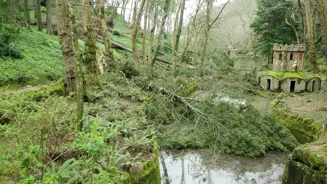The storm that devastated the Park of Pena
12 Jan 2024

On 19 January 2013, a violent storm hit Portugal from north to south, destroying homes, leaving thousands without water and electricity for several days, and causing several injuries. Indeed, official figures show that one person even lost their life. The next day, in the Park of Pena, the scene was devastating: the fall of more than 2,000 trees led to the partial destruction of buildings such as the Guard House of the Chalet of the Countess of Edla (the ticket office) and the Park's path networks and infrastructure.
This was a rare phenomenon in a Portuguese winter: a "very deep" and rapid depression, an "explosive cyclogenesis", which unleashed winds of 140 km/h and a rise in the average sea level, as a specialist from the Portuguese Institute for the Sea and Atmosphere (IPMA) explained to the newspaper Expresso.
The extent of the damage was such that, for reasons of safety, the Park of Pena was partially closed for more than six months. Roads and footpaths had to be unblocked, gardens and areas of woodland had to be cleared, and buildings had to be restored, among many other tasks.

Faced with this unique situation, and in response to the numerous offers that immediately came flooding in, Parques de Sintra organised a volunteer drive (which was fully subscribed in 24 hours). Thus, on 26 January 2013, 200 volunteers from the local community and Greater Lisbon got down to work and helped clean up a considerable area of the Park of Pena.
Let's look at the figures:
- Of the 85 hectares that make up the park, 75 were affected by the storm.
- Volunteers helped clear 3.5 hectares, which corresponds to 4% of the park's area.
- In this volunteer initiative, 18m3 of leaves were removed, 160m3 of branches were sorted into piles, and approximately 12m3 of wood chips were produced.
- Hundreds of metres of ditches were cleared, allowing water to flow again, and a large part of the more than 2 km of paths on which the volunteers worked were swept.

Recovery efforts and the unpredictability of nature
Little by little, the Park of Pena began to regain its shine. While the painstaking (and challenging) task of cutting down and removing fallen trees was carried out, alongside clean up and restoration of the built and natural heritage, the Parques de Sintra team also began a reforestation process in January 2014 to replace the lost tree specimens. A total of 285 medium-sized young trees were planted. The aim of this intervention was to "restore the ambience that existed before the storm, recovering a fairly dense forest of conifers and hardwoods, including firs, cedars, junipers, cypresses, spruces, sequoias, tsugas, tulip trees, beeches, and lindens. The trees were planted at a set pace, as is usual in forestry plantations, but following a plan that follows the principles and aesthetic aspects of reference for intervention in romantic parks and gardens of the 19th century, such as the Park of Pena" explains Parques de Sintra's landscape architect, Elsa Isidro.

But nature is unpredictable: no matter how much you try to keep everything under control, it is hard to predict events. The last quarter of that same year saw another extreme weather event which caused around 900 adult trees to fall, the partial destruction of the roof of Pena Farm's main greenhouse, the collapse of property boundary walls and retaining walls inside the park, the destruction of pavements and ditches along the park's paths, and the bursting of the water tank used for irrigating the Garden of the Countess of Edla. Fortunately, it was possible to reopen the park to the public within a few weeks, but new efforts had to be made to survey the damage and start new heritage restoration projects.
These processes are time-consuming and involve controlling the spontaneous regeneration of woody invasive species, the ordering of specific species (following the choice of plants found in the records of Professor Mário de Azevedo Gomes' monograph of 1960), and the planting many hundreds of trees. Indeed, work to restore trail of destruction left behind by these natural phenomena was still being carried out in 2023, in particular by cutting back the plots planted in previous years.
The truth is that the balance turned out to be positive: the storms destroyed around 2,900 trees, but over the last few years, 6,768 have been planted. Anyone who visits the Park of Pena will once again be able to lose themselves among the greenery, be carried away by the rays of sunlight that penetrate the treetops, or simply sit and contemplate the wonders that nature both provides and threatens to take away from us.
